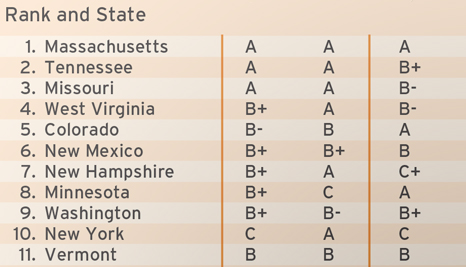Since No Child Left Behind (NCLB) was enacted into federal law in 2002, states have been required to test students in grades 3 through 8 and again in high school to assess math and reading achievement. The federal law also asks states to establish the performance level students must reach on the exams in order to be identified as “proficient.” According to NCLB, each school was expected to increase the percentage of proficient students at a rate that would ensure that all students were proficient by the year 2014. Student proficiency rates have been publicly reported every year for schools in every state as well as for the state as a whole. Importantly, each state chooses its own tests and sets its own proficiency bar.
NCLB also requires the periodic administration of tests in selected subjects to a representative sample of students in 4th and 8th grade as part of the National Assessment of Educational Progress (NAEP), also known as the nation’s report card, which is administered under the auspices of the U.S. Department of Education. The performance levels considered proficient on NAEP tests are roughly equivalent to those set by international organizations that estimate student proficiency worldwide.
The availability of data from both NAEP and from tests administered by each state allows for periodic estimates of the rigor of each state’s proficiency standards. If the percentage of students identified as proficient in any given year is essentially the same for both the NAEP exam and for a state’s tests, it may be inferred that the state has established as rigorous a proficiency standard as that set by NAEP. But if percentages of students identified as proficient are higher on a state’s own tests than on NAEP tests, then it may be concluded that the state has set its proficiency bar lower than the NAEP standard.
Since NCLB was enacted into law, Education Next has used this information to identify the rigor of state proficiency standards each time the results from state and NAEP tests have become available. This is the sixth in a series of reports that grade state proficiency standards on the traditional A-to-F scale used to evaluate students. Each state is graded according to the size of the differential between the percentages of students identified as proficient by the state and the percentages identified by NAEP on the 4th- and 8th-grade math and reading exams. In the five previous reports (most recently, “Despite Common Core, States Still Lack Common Standards,” features, Fall 2013), it has been shown that proficiency standards in the average state have been set at a much lower level than those set by NAEP. Also, the reports reveal wide variation among the states in the standards they have established. Further, prior reports have shown that up until 2011 the proficiency standards set by states initially did not, on average, rise significantly.
In 2009, with funding from the Bill & Melinda Gates Foundation, the National Governors Association and the Council of Chief State School Officers formed a consortium that established the Common Core State Standards (CCSS), curricular standards that outline what students should know and be able to do at each grade level. Many states have committed themselves to implementing “college and career ready” standards, such as those outlined in CCSS, in exchange for receiving a waiver from many NCLB regulations granted by the U.S. Department of Education. So far, 44 states and the District of Columbia have adopted CCSS for at least one subject. One of the consortium’s goals is to encourage states to set proficiency levels that are on par with those set by NAEP.
In this paper we extend the five prior analyses by identifying the changes in state proficiency standards between 2011 and 2013, the last year for which the relevant information is available. We show that many states have raised their proficiency bars since 2011. Indeed, the 2013 data reveal that for the first time, substantially more states have raised their proficiency standards than have let those standards slip to lower levels. Overall, 20 states strengthened their standards, while just 8 loosened them. In other words, a key objective of the CCSS consortium—the raising of state proficiency standards—has begun to happen.
Still, these advances have been marginal. There is more than enough room for growth, especially among the states that have yet to adopt CCSS.

Measuring State Proficiency Standards
To identify changes in state proficiency standards, we use the same procedures as in our five prior analyses. We estimate each state’s proficiency standards in reading and math in grades 4 and 8 by identifying the difference between the percentages of students the state identifies as proficient and the corresponding percentages of students identified as proficient by NAEP. If for any given state the differences in the percentage proficient on the state tests and the NAEP tests are small, we interpret those results as showing that the state has set high, internationally competitive standards. But if for any given state the percentages proficient on the state tests are much higher than those reported for the state by NAEP, then we conclude that the state has set its proficiency standards much lower than the international bar that CCSS is encouraging.
We report in Table 1 a grade for each state for each of four tests (4th-grade math, 4th-grade reading, 8th-grade math, and 8th-grade reading). The average of these grades provides an overall grade for the state, also shown in Table 1. (The specific numeric differentials between state and NAEP proficiency rates for each grade and test are available at www.educationnext.org/edfacts.)
It is important to understand that high grades do not indicate high student performance. Rather, high grades indicate that states are setting a high bar. Grades assess “truth in advertising,” indicating the degree to which states are accurately informing parents how well students are doing on an internationally accepted scale (see sidebar, “Grading the States,” below).

Stricter Standards
 Although state proficiency standards are not yet at international levels, they moved in that direction between 2011 and 2013. Over that two-year period, the average difference between NAEP and state proficiency levels decreased from 35 percent to 30 percent, the largest tightening of state standards in any two-year period since NCLB was first established (see Figure 2). No fewer than 20 states raised their proficiency standards, while just 8 let them slide. By comparison, between 2009 and 2011, proficiency standards improved by only 2 percentage points. Even that gain was due only to the fact that a few states raised their standards sharply. Overall, 27 states actually lowered their proficiency standards in the two-year period prior to 2011, while only 11 states raised them (see Table 2).
Although state proficiency standards are not yet at international levels, they moved in that direction between 2011 and 2013. Over that two-year period, the average difference between NAEP and state proficiency levels decreased from 35 percent to 30 percent, the largest tightening of state standards in any two-year period since NCLB was first established (see Figure 2). No fewer than 20 states raised their proficiency standards, while just 8 let them slide. By comparison, between 2009 and 2011, proficiency standards improved by only 2 percentage points. Even that gain was due only to the fact that a few states raised their standards sharply. Overall, 27 states actually lowered their proficiency standards in the two-year period prior to 2011, while only 11 states raised them (see Table 2).
Which states changed the most? For the first time since this survey of state standards has been undertaken, no fewer than nine states receive a grade of “A,” indicating they have set a proficiency bar that is roughly comparable to that set by NAEP. Joining Massachusetts and Tennessee, the only two states given that top grade in 2011, are Kentucky, Missouri, New York, North Carolina, Pennsylvania, Utah, and Wisconsin. Five of these states (Massachusetts, New York, North Carolina, Pennsylvania, and Wisconsin) have even set some standards that exceed those of NAEP. Six states (Kentucky, North Carolina, Pennsylvania, Utah, Wisconsin, and Michigan) should be commended for improving by more than two letter grades between 2011 and 2013. All of these states have adopted CCSS. Meanwhile, only New Hampshire’s standards have dropped by a full letter grade.
CCSS may be driving these changes. One indication that this may be the case is that the six states that are not implementing CCSS for reading or math all continue to set low proficiency standards. Their grades: Virginia, C+; Nebraska, C; Indiana, C-; Texas, C-; Alaska, D+; and Oklahoma, D.
Not There Yet
Although many states have established more rigorous proficiency standards, there remains, on average, a 30-point differential between the percentage of students defined as “proficient” by the average state and the percentage of students considered proficient by NAEP. That constitutes a large gap for CCSS to close, raising the possibility that the introduction of higher proficiency standards nationwide could be fraught with political controversy that could endanger full CCSS implementation. Already, CCSS is coming under pressure from critics (see “No Common Opinion on the Common Core” features, Winter 2015), and the criticism could intensify when the public is informed that a higher percentage of a state’s students are not proficient. The criticisms could intensify even further later in 2015 when the initial results from the Common Core–aligned PARCC (Partnership for Assessment of Readiness for College and Careers) and Smarter Balanced tests will be released. With a rising bar, student performance could appear to be lower even when it is the bar itself—not student performance—that has changed. If the press does not interpret the test results properly, needless new political controversies could easily arise, a development that has already happened in the state of New York, one of the first states to raise its proficiency bar in both subjects to the level expected by CCSS.
 The controversy could be dampened, however, by the fact that most states no longer need to comply with NCLB requirements that they penalize schools for not making state-defined proficiency targets. Since the U.S. Department of Education has waived many NCLB regulations in exchange for states’ engaging in alternative reform strategies, states are under less pressure to keep their proficiency standards at a low level. Indeed, the waivers—as well as CCSS expectations—may help to account for the increasing rigor of state standards since 2011. As long as NCLB regulations were being enforced, school districts had strong incentives to resist the establishment of high proficiency standards within their state. Had states raised proficiency standards, fewer students would be considered proficient and local schools would have been subject to increasingly severe penalties. Now that many of those rules have been waived by the U. S. Department of Education for the vast majority of the states, they no longer need to be worried about penalties if lower percentages of students are identified as proficient. If CCSS works as its proponents expect, higher proficiency standards could drive schools and students to reach international levels of performance.
The controversy could be dampened, however, by the fact that most states no longer need to comply with NCLB requirements that they penalize schools for not making state-defined proficiency targets. Since the U.S. Department of Education has waived many NCLB regulations in exchange for states’ engaging in alternative reform strategies, states are under less pressure to keep their proficiency standards at a low level. Indeed, the waivers—as well as CCSS expectations—may help to account for the increasing rigor of state standards since 2011. As long as NCLB regulations were being enforced, school districts had strong incentives to resist the establishment of high proficiency standards within their state. Had states raised proficiency standards, fewer students would be considered proficient and local schools would have been subject to increasingly severe penalties. Now that many of those rules have been waived by the U. S. Department of Education for the vast majority of the states, they no longer need to be worried about penalties if lower percentages of students are identified as proficient. If CCSS works as its proponents expect, higher proficiency standards could drive schools and students to reach international levels of performance.
That proficiency standards have for the first time begun to move in the right direction is a hopeful sign. Later this year we shall have new information from NAEP and state tests that will allow us to see whether the progress made up through 2013 has persisted into 2015 and beyond. If that should happen, and if student performance shifts upward at the same time, it will signal a long-awaited enhancement in the quality of the American school. One reason for expecting still further shifts upward in the proficiency bars states are setting is that the Smarter Balanced standards accepted by a number of states seem to be very similar to those set by NAEP. And even those states rejecting the Common Core are claiming that they, too, believe in high standards, although calls for cutbacks in state testing can also be heard. Still, higher expectations for students may become more than just a rhetorical phrase. As soon as the next round of NAEP and state testing data become available, we should have some indication whether the recent changes are a precursor of what is to come or merely a temporary spike in official state policies.
Paul E. Peterson, editor-in-chief of Education Next, is professor of government and director of the Program on Education Policy and Governance at the Harvard Kennedy School, where Matthew Ackerman is a research fellow.
This article appeared in the Summer 2015 issue of Education Next. Suggested citation format:
Peterson, P.E., and Ackerman, M. (2015). States Raise Proficiency Standards in Math and Reading: Commitments to Common Core may be driving the proficiency bar upward. Education Next, 15(3), 16-21.






